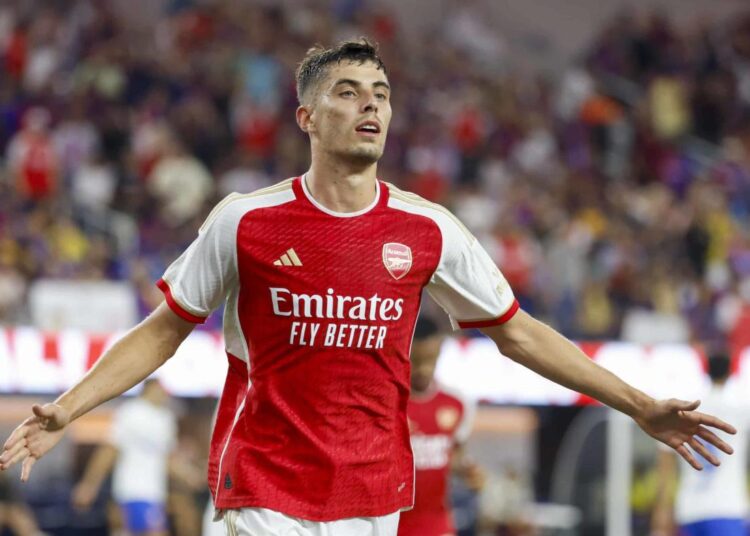It was the 53rd minute of Kai Havertz’s 10th official appearance for Arsenal when the tide finally turned for the £65 million forward. He hadn’t yet registered a goal or assist, and the weight of expectation seemed to inhibit his early performances for Mikel Arteta’s side. On a warm afternoon at Bournemouth’s Vitality Stadium, the German international wasn’t showing the quality that Arsenal had hoped for when they signed him from Chelsea.
But then, a gesture of confidence came from Martin Ødegaard. The Norwegian captain handed Havertz the ball for a penalty. It was a small moment of selflessness, but it made a world of difference. Havertz stepped up, converted the spot kick, and was serenaded by Arsenal’s travelling supporters for the first time.
It was a turning point, but not an overnight fix. For Havertz, finding his feet at Arsenal has been a process, one rooted not only in his technical ability but also in the club’s unique approach to fostering motivation and growth.
Arteta’s Personalised Approach to Unlocking Havertz
The summer of 2023 marked a key decision point in Havertz’s career. After three mixed seasons at Chelsea, where he’d seen managers come and go in quick succession, he needed stability. When Mikel Arteta reached out during Havertz’s holiday in Greece, it wasn’t just another standard recruitment pitch. As reported by Eldesmarque, Arsenal had done their homework.
During their conversation, Arteta showed Havertz a series of personalised slides that included input from his family, former coaches, and even pictures of his dogs. It was a different kind of pitch, one designed not only to emphasise Havertz’s footballing potential but also to appeal to his need for a nurturing, family-oriented environment. Arteta’s message was simple: this was not a short-term fix but a long-term project to develop Havertz into a more complete player.
Havertz, who had struggled with the constant upheaval at Chelsea and the nine different managers he worked under at Bayer Leverkusen and Stamford Bridge, was sold on the idea of a stable and supportive environment. Arteta’s approach hit the mark.
Why Havertz Needed Stability
To understand why Havertz has begun to thrive under Arteta, it’s essential to appreciate his background. Raised in Aachen, Germany, in a middle-class family, Havertz’s journey into football was different from many of his peers. He wasn’t driven by the need to escape poverty but by a personal motivation fostered by his grandfather, Richard, who played in Germany’s top division in the 1950s.
Richard’s untimely death when Havertz was only five years old had a profound impact on him and his family. It instilled in Havertz a deep appreciation for family support—a quality he later found vital in his footballing journey. During his formative years at Bayer Leverkusen, he faced struggles, including a painful growth spurt and a period of homesickness. It wasn’t until his brother moved to be with him that Havertz’s fortunes improved, underscoring the importance of a close support network.
Arteta understood this about Havertz, and he used that knowledge to create a system where the German could feel valued and supported. The results are now starting to show. Havertz has become a crucial cog in Arsenal’s tactical machine, but it’s his sense of belonging that is arguably the most important element in his resurgence.
Arsenal’s Culture: A Perfect Fit for Havertz
The culture at Arsenal is a far cry from the turbulent environment at Chelsea. At Arsenal, team-building exercises like barbecues, shared responsibilities for caring for the club’s dog (Win), and a seating plan that encourages interaction among players create a familial atmosphere. It’s this sense of community that has allowed Havertz to regain his confidence.
Havertz once remarked that he found the structured nature of modern football at elite clubs to be at odds with his more free-spirited approach to the game. His early obsession with Barcelona’s treble-winning side from 2005-06 reflected a love for creative, fluid football. However, he struggled to express that creativity within rigid tactical systems, particularly during his time at Chelsea.
Arteta has embraced Havertz’s versatility, seeing it as a strength rather than a hindrance. Whether playing as a left-sided No. 8, a second striker, or a more central forward, Havertz has adapted to multiple roles within the Arsenal side. Arteta has been quick to point out that Arsenal’s formations are not as rigid as they may appear on paper. Instead, the team shifts through various shapes throughout a game, allowing players like Havertz to exploit space and use their footballing intelligence.
Havertz’s ability to interpret space and instinctively know when to drop deep or make a forward run has made him invaluable to Arteta’s system. His transformation into a more imposing centre-forward has added another dimension to Arsenal’s attack, giving them a physical presence that they had been lacking.
Becoming Arsenal’s Aerial Threat
One of the most striking aspects of Havertz’s development over the past year has been his improvement in the air. Standing at 6ft 4in, Havertz always had the physical attributes to dominate in aerial duels, but it wasn’t until he joined Arsenal that he truly embraced this part of his game.
Previously known as a more laid-back player, Havertz’s early performances often gave the impression of someone not fully exploiting their physical gifts. But Arteta has worked to change that. By focusing on positive body language and encouraging Havertz to be more aggressive in the air, the manager has helped round out the German’s game.
The results have been evident. Havertz’s aerial prowess has become a crucial weapon in Arsenal’s attacking arsenal. His ability to contest headers and bully opposition defenders has added a new dimension to the team’s play. It’s a stark contrast to the player who initially struggled to impose himself in midfield.
Havertz’s Evolution Under Arteta
While the goals and assists have started to come in greater numbers, it’s the overall evolution of Havertz’s game that stands out. His understanding with Arteta is a key reason why he’s been able to flourish at Arsenal, and the manager’s patience with him is paying off.
As Eldesmarque noted, “Havertz sees talk about rigid positions as outdated.” He’s part of a new generation of footballers who view the game as fluid and position-less. Arteta’s tactical flexibility, which often sees Arsenal shift between multiple formations during a game, has allowed Havertz to play to his strengths.
The German’s versatility has been a blessing for Arteta, who has used him across several positions. But it’s also been a curse at times, with critics pointing out that Havertz doesn’t have a defined role within the team. However, both player and manager seem to view this as a strength rather than a weakness.
Arteta’s vision for Havertz is clear: he sees a player who can contribute in multiple areas of the pitch, whether it’s in midfield, as a second striker, or as a centre-forward. And as Havertz has grown more comfortable in this system, his performances have improved.
What’s Next for Havertz and Arsenal?
Havertz’s resurgence has come at a crucial time for Arsenal. As the team continues to push for silverware, the German’s contributions will be key. His six goals across three competitions this season are already an improvement on his early struggles, and the understanding he has developed with his teammates, particularly Martin Ødegaard, has been a driving force behind Arsenal’s success.
The pressure that once weighed heavily on Havertz has begun to lift, and his confidence is growing with each performance. Arteta’s long-term plan for Havertz is beginning to bear fruit, and the player is finally showing why Arsenal invested so heavily in him.
As Havertz continues to develop under Arteta’s guidance, there’s a growing sense that his best is yet to come. The foundations have been laid, and the belief that he can be a pivotal figure in Arsenal’s pursuit of success is now stronger than ever.
Read the full article here


























